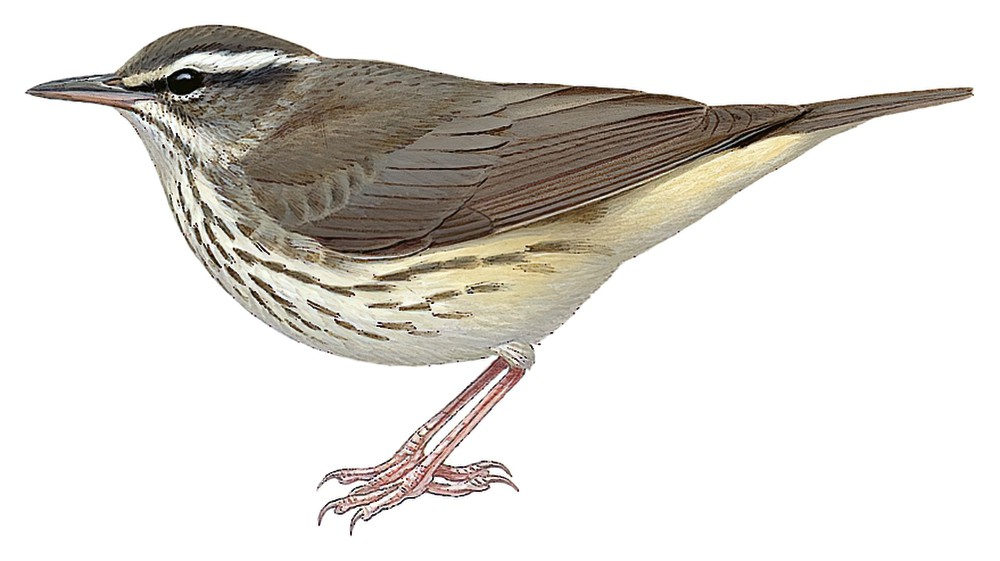Louisiana Waterthrush / Parkesia motacilla

Louisiana Waterthrush
SCI Name:
Protonym: Turdus motacilla Hist.Nat.Ois.Am.Sept. 2 p.9 pl.65 ydP
Taxonomy: Passeriformes / Parulidae / Parkesia
Taxonomy Code: louwat
Type Locality: Kentucky.
Author: Vieillot
Publish Year: 1809
IUCN Status: Least Concern
DEFINITIONS
PARKESIA
(Parulidae; Ϯ Northern Waterthrush P. noveboracensis) Dr Kenneth Carroll Parkes (1922-2007) US ornithologist; "The evidence reviewed above implies that the generic name Seiurus should be restricted to Ovenbird; Seiurus thus becomes a monotypic genus. The synonymy of Seiurus includes five names ... Enicocichla G. R. Gray, 1840 ... Siurus Strickland, 1841 ... Senurus Reichenbach, 1849 ... Henicocichla Cabanis, 1851 ... and Exochocichla van der Hoeven, 1855. ... None of these, however, is applicable to the waterthrushes. Because no generic name is currently available for the Northern and Louisiana Waterthrushes, this group may be known as: Parkesia, gen. nov. Type species Motacilla noveboracensis J. F. Gmelin, 1789 (currently Seiurus noveboracensis) ... It is a great pleasure to name this taxon for the late Kenneth C. Parkes, former curator at the Carnegie Museum of Natural History, Pittsburgh, to honour his lasting contributions to avian taxonomy, moult terminology, hybridisation and faunistics. Attachment of his name to the waterthrushes is appropriate given his long interest in Parulidae. The gender of the name Parkesia is feminine." (Sangster 2008).
MOTACILLA
(Motacillidae; Ϯ White Wagtail M. alba) Late Med. L. (1555) motacilla pied wagtail < L. motacilla wagtail < Gr. μυττηξ muttēx type of bird mentioned by Hesychius. The mistaken use of -cilla for “tail” in ornithology goes back to mediaeval writers who misread motacilla, Varro’s name for the wagtail ("quod semper movet caudam") and a diminutive from motare to move about or shake (i.e. a little shaker or wagger), as “shaketail”; "99. MOTACILLA. Rostrum subulatum, rectum: Mandibulis subæqualibus. Nares obovatæ. Lingua lacero-emarginata." (Linnaeus 1758);"Motacilla Linnaeus, 1758, Syst. Nat., ed. 10, p. 184. Type, by tautonymy, "Motacilla" = M. alba Linnaeus." (Vaurie in Peters 1960, IX, 130). Linnaeus's Motacilla comprised thirty-four species (M. Luscinia, M. Calidris, M. modularis, M. Schœnobænus, M. campestris, M. Curruca, M. Hippolais, M. Salicaria, M. Sylvia, M. Philomela, M. Ficedula, M. alba, M. flava, M. Tiphia, M. Ruticilla, M. hispanica, M. Oenanthe, M. Rubetra, M. Atricapilla, M. Emeria, M. Phœnicurus, M. Erithacus, M. Titys, M. svecica, M. Sialis, M. Velia, M. Spiza, M. Rubecula, M. Troglodytes, M. Regulus, M. Trochilus, M. Acredula, M. Pendulinus, M. minuta). The White Wagtail has a wide range in the Palaearctic, although several subspecies are sometimes treated specifically (e.g. yarrellii, subpersonata, personata, lugens).
Var. Matacilla, Metacilla, Motacilea, Motacitta, Mottacilla, Montacilla, Notacilla, Notorcilla.
Synon. Aguimpia, Atolmodytes, Boarula, Budytes, Calobates, Pallenura, Pecula, Psomophilus, Seisura.
motacilla
L. motacilla wagtail < Gr. μυττηξ muttēx type of bird mentioned by Hesychius (subsp. Myiothlypis fulvicauda, Parkesia).
UPPERCASE: current genus
Uppercase first letter: generic synonym
● and ● See: generic homonyms
lowercase: species and subspecies
●: early names, variants, mispellings
‡: extinct
†: type species
Gr.: ancient Greek
L.: Latin
<: derived from
syn: synonym of
/: separates historical and modern geographic names
ex: based on
TL: type locality
OD: original diagnosis (genus) or original description (species)












